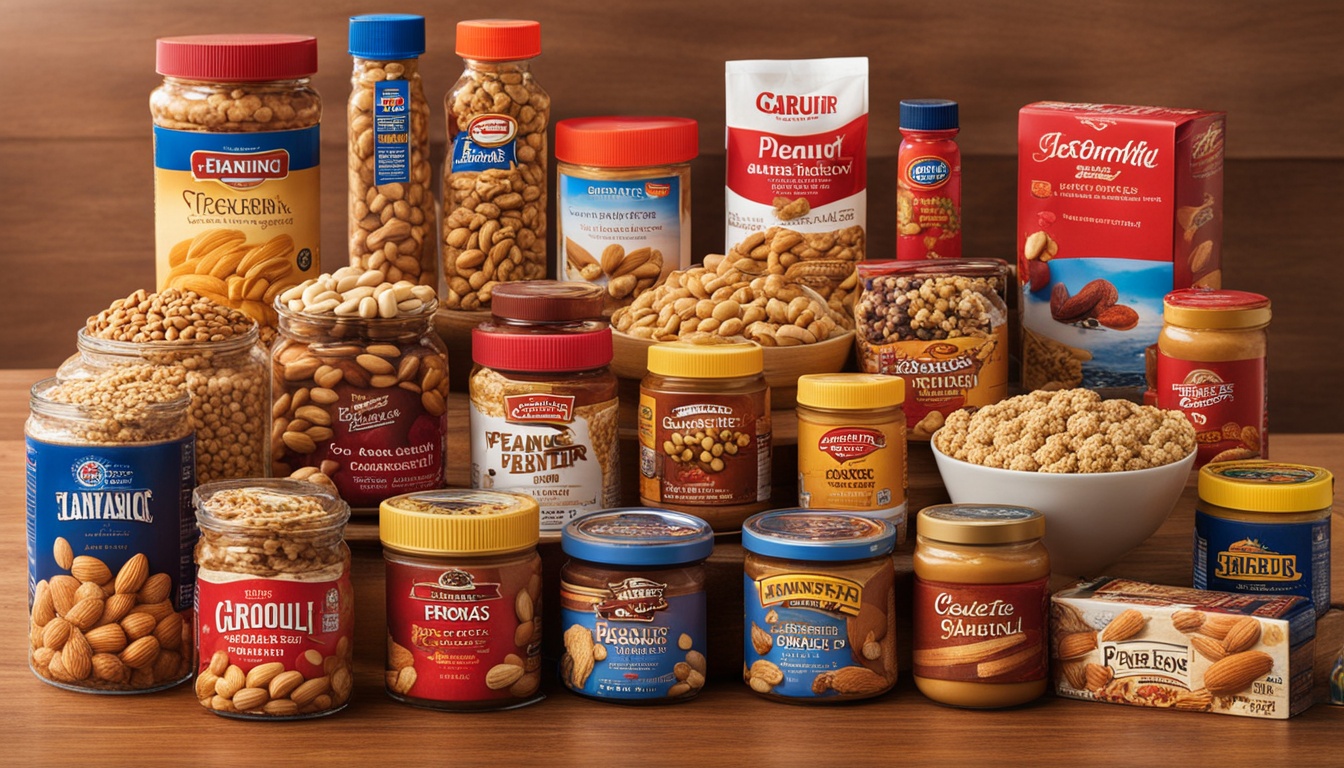Are you confused about which Foods to Avoid with a Peanut Allergy ? Peanut and tree nut allergies are a big issue for about 3 million Americans. Just a tiny bit of peanut can cause a serious allergic reaction. This includes things like skin rashes, hives, and trouble breathing. It’s critical for people with peanut allergies to watch what they eat.
This problem is really common in kids, affecting around 2% of them in the U.S. If you have this allergy, you must avoid peanuts completely. Even cooking or processing doesn’t remove the proteins that cause reactions. Always read food labels and talk to restaurant staff to stay safe from peanuts.
Key Takeaways
- Peanut and tree nut allergies affect millions of Americans, with even small amounts triggering severe reactions.
- Peanut allergy is a common condition in children, affecting about 2% of kids in the U.S.
- The only way to prevent an allergic reaction is to completely avoid peanut and peanut-containing products.
- Carefully reading food labels and communicating with restaurant staff are crucial for managing peanut allergies.
- Cross-contamination poses a significant risk, so awareness of hidden peanut sources is essential.
Foods to Avoid with a Peanut Allergy | Safe Eating Guide
What is a Peanut Allergy?
A peanut allergy makes the immune system react strongly to peanut proteins. It treats these proteins as harmful invaders. This reaction causes the body to release chemicals that lead to allergy symptoms.
Symptoms of a Peanut Allergy Reaction
Being allergic to peanuts can cause various symptoms. You might see skin rashes or swelling. Breathing problems, stomach issues, and a feeling of severe fear or doom can also happen. A tiny amount of peanut can trigger these reactions, whether eaten or breathed in.
Causes of Peanut Allergies
Even after peanuts undergo processing or digestion, their proteins stay intact. If your body starts making antibodies against these proteins, you may develop a peanut allergy. Essentially, this is your immune system’s extreme response to peanut proteins.
In the United States, about 2% of children have a peanut allergy, making it pretty common. Doctors diagnose peanut allergies using skin or blood tests. These tests look for certain antibodies to peanuts.
Peanut Allergy Foods to Avoid
Having a peanut allergy means being very careful with what you eat. Foods like baked goods and certain cuisines can contain peanuts. Knowing what peanut ingredients are common is key to staying safe.
Peanut Ingredients and Names
Look out for terms like arachic oil, arachis, and more. These can all mean peanuts are in the food. Even types like Spanish or Virginia peanuts could be risky for you.
Baked Goods and Sweets
Peanuts sneak into many baked items, like cookies, cakes, and pies. They’re also in candies, chocolate, cereals, and more. Always check the ingredients and ask about nuts before eating these treats.
Ethnic Cuisines
Eating out can be tough with a peanut allergy, especially with certain cuisines. Foods from African, Asian, and Mexican restaurants often contain peanuts. Be careful and ask questions to avoid cross-contact.
Sauces and Condiments
Watch for peanuts in sauces and dressings too. Reading labels and asking about what’s in them is important. Hidden peanuts in these products can cause allergic reactions.
There’s always a risk of peanuts being in food, even if it’s not listed. Cross-contact happens when foods touch shared equipment. Always read labels and talk to those preparing your food to stay safe.
Reading Food Labels
For people with a peanut allergy, reading food labels is a must. Thanks to the FALCPA, if a food has peanuts, it’s marked. This could be on the ingredient list or on a separate note. So, finding peanut products on labels is easier.
Identifying Peanut Allergens
Yet, not all foods are covered by these rules. Items like makeup, meds, pet food, and dishes from restaurants may not have clearly marked peanuts. Always check the whole ingredient list and ask how the food is made. If you’re unsure about a label, it’s safer not to eat it. This helps to avoid allergic reactions.
Labeling Laws and Regulations
Thanks to the Food Allergen Labeling Consumer Protection Act, peanuts and other major allergens must be listed. Even if a tiny amount is present, it must be declared. But, “may contain” warnings are up to the food maker. So, be aware of these laws and always read labels carefully to keep safe.

Peanut Oil Safety
Understanding peanut oil safety is crucial. You need to know the difference between highly refined and unrefined types. Highly refined peanut oil is not labeled as an allergen because it usually doesn’t contain the proteins that cause allergic reactions. This is confirmed by a reliable source.
Highly Refined Peanut Oil
The FDA does not require highly refined peanut oil to be labeled as an allergen. The reason is, through refining, the proteins that cause allergic reactions are reduced. So, for most people with a peanut allergy, highly refined peanut oil is safe to consume. Always check with an allergist first, just to be sure.
Cold-Pressed or Expeller-Pressed Peanut Oil
Cold-pressed, expeller-pressed, or extruded peanut oils do contain allergenic proteins. So, they are risky for anyone with a peanut allergy. Even though these unrefined oils offer unique flavors, they haven’t gone through the same process to remove allergens. This means using them or coming into contact with them can cause allergic reactions.
Checking labels and asking manufacturers is crucial for those avoiding peanuts. Your allergist can give specific advice on peanut oil consumption:
Cross-Reactivity and Related Foods
People allergic to peanuts should know there’s a chance other foods might cause a reaction. Even though peanuts are legumes, they’re often thought of as tree nuts because they can get mixed up or touch each other. This confusion is especially true for kids. So, if you’re allergic to peanuts, it’s usually best to stay away from tree nuts like almonds and walnuts too.
Tree Nuts and Peanut Allergy
Even though peanuts aren’t tree nuts, they have some of the same proteins. So if you’re allergic to peanuts, you might also react to tree nuts. This could be because they’re mixed, or kids might find it hard to tell the difference.
Lupin and Peanut Allergy
There’s a new legume called lupin, showing up in stuff like gluten-free foods. If you’re allergic to peanuts, lupin could cause a reaction too. That’s because lupin has proteins similar to peanuts’. This means there’s a chance they could both cause issues.
Other Legumes and Peanut Allergy
Most people with a peanut allergy can eat other legumes, like soy or lentils, without a problem. But, talking to an allergist is crucial. In some situations, certain legumes should also be avoided. An allergist can recommend the best steps, including which legume-related foods to cut out if needed.
Dealing with peanut-related food allergies and cross-reactivity needs careful attention. Regular checks with a healthcare expert are very important. They can give advice to keep you safe and lower the chances of a bad reaction.
Dining Out and Cross-Contamination
Dining out is tough for people with a peanut allergy. Cross-contamination in restaurants is a big issue. Most states in the U.S. do not require restaurants to help with food allergies.
So, it’s key to talk clearly with the restaurant staff. Let them know about your allergy and what foods you can’t have. This is super important to stay safe.
Communicating with Restaurant Staff
If you’re eating out with a peanut allergy, ask lots of questions. Know what’s in the food you may order. You can give the staff a “chef card” that explains your allergy.
The card helps the kitchen understand how to keep your food safe. Look for places that have special menus for allergies. They might be better prepared to meet your needs.
Avoiding Cross-Contact
Even if you order something peanut-free, it could still get contaminated. This happens if the food touches tools or surfaces used with peanuts. Being careful is very important.
Keep an eye on how your meal is made. If something worries you, speak up to the staff. This can lower the chance of accidentally eating something with peanuts.

Managing Peanut Allergies in Children
About 2% of kids in the U.S. have a peanut allergy, says the second source. For these children, keeping them safe is very important. Schools and daycares, especially, must work with parents to make a safe plan. This plan ensures the child is well taken care of despite their allergy.
School and Daycare Precautions
This safety plan may mean no peanut snacks in their class or lunchroom. Teachers and caregivers need to know how to spot allergy signs and how to use an epinephrine injector. By teaming up with schools and daycares, a safer, peanut-free space can be made. This reduces the chance of the child getting sick due to peanuts.
Educating Caregivers
The second source also points out the need to teach everyone who looks after the child. This includes babysitters, family, and friends. It’s important they know how to avoid peanuts and what to do in an emergency. Education and clear instructions on dealing with the allergy are a must. This helps make sure the child is safe wherever they are.

Outgrowing Peanut Allergies
Though usually lifelong, some kids may outgrow a peanut allergy. One study showed about 20% of these children stop being allergic. So, one in five kids might have their peanut allergy go away with time.
Likelihood of Outgrowing Peanut Allergy
Most children with peanut allergies keep them for life. But, it’s smart to see an allergist for check-ups. They can tell if the allergy might fade as kids grow up by doing tests and watching closely.
Once kids stop being allergic to peanuts, they must be careful. Eating peanuts again, even a little, could make the allergy come back. So, keeping up with the allergist’s advice is key, even if the allergy seems gone.

Treatments for Peanut Allergies
Dealing with a peanut allergy means avoiding peanuts in your diet. But, there are now helpful treatments available. These include oral immunotherapy (OIT) and FDA-approved peanut allergy medications.
Oral Immunotherapy (OIT)
Oral immunotherapy helps by giving the patient small but increasing amounts of peanut protein. Recent studies suggest that peanut therapy drops under the tongue are a safe way to start this process. This method can make someone less allergic to peanuts, lowering the risk of serious reactions.
FDA-Approved Treatments
The oral immunotherapy (OIT) treatment called Palforzia has been approved by the FDA for peanut allergies. This is a step forward. Allergists offer similar treatments, using peanut protein powder, to increase peanut tolerance over time.
It’s important to talk with your allergist about treatment options. What works best can vary from person to person. They will help you find the right approach for your situation.
Preventing Reactions and Emergencies
If you have a peanut allergy, avoiding these foods is crucial to stay safe. Carry two epinephrine auto-injectors with you, like EpiPen, everywhere. Knowing how anaphylaxis looks and having the right medicine is key.
Epinephrine Auto-Injectors
Epinephrine is vital for preventing peanut allergy reactions and halting anaphylaxis. Always keep two epinephrine auto-injectors close and learn to use them right.
Recognizing Anaphylaxis Symptoms
Anaphylaxis is a serious and sometimes deadly reaction. It might show as skin issues, swelling, breathing struggles, stomach upsets, and fear of something bad coming. Knowing these anaphylaxis symptoms helps in quick action to save a life.
Emergency Action Plan
An emergency action plan for peanut allergies is a must. It should include using epinephrine, calling 911, and getting medical help ASAP when a bad allergic reaction happens.
Conclusion
Managing a peanut allergy means staying away from foods with peanuts. This is the best way to avoid a dangerous allergic reaction. Read food labels, talk to cooks, and know where peanuts might be hiding. For many, a peanut allergy lasts a lifetime, but some people may outgrow it.
New treatments, like oral immunotherapy, offer hope for those with peanut allergies. It’s crucial to be aware, prepared, and work with your doctor. Together, you can navigate life safely. Know how to avoid peanut allergens to stay healthy and lower the risk of a reaction.
Living with a peanut allergy takes being careful but with support, you can enjoy life. Always carry your epinephrine auto-injector and stay in touch with your allergist. They will help you develop the best plan for dealing with your peanut allergy.
FAQ
What is a peanut allergy?
A peanut allergy makes the immune system react to proteins in peanuts. It sees them as harmful and starts an allergic reaction.
What are the symptoms of a peanut allergy reaction?
Signs of a peanut allergy reaction include skin rashes, itchiness, and swelling. They might also have trouble breathing, stomach pain, or feel like something bad is going to happen.
What causes a peanut allergy?
Antibodies are created in response to peanut proteins. These antibodies cause the immune system to release chemicals, such as histamine, which leads to allergic symptoms.
What foods should be avoided with a peanut allergy?
Stay away from foods with peanuts, like peanut butter. Also avoid ingredients that sound like peanuts or contain peanuts, such as peanut flour or arachis oil.
Carefully check labels of baked goods, candies, and sauces. Peanuts can hide in many types of food.
How can peanut allergens be identified on food labels?
The FALCPA makes sure peanut is clearly shown on food labels. It can be in the ingredients list or a “Contains” statement. But, some products may have peanuts that are not labeled.
Is all peanut oil safe for those with a peanut allergy?
Not all peanut oil is safe if you have a peanut allergy. Only peanut oil that is highly refined, and with the proteins removed, is okay. Cold-pressed or unrefined peanut oils can trigger an allergy and should be avoided.
Can people with a peanut allergy also react to other foods?
Yes, if you’re allergic to peanuts, you might also react to tree nuts or lupin. Talking to an allergist can help you understand if other foods might bother you too.
How can the risks of cross-contamination be minimized when dining out with a peanut allergy?
When eating out, tell the restaurant about your allergy and ask how food is prepared. Giving the chef a card with allergy information can also help. Pick restaurants that understand and follow safe food practices.
What precautions should be taken when a child has a peanut allergy?
If your child has a peanut allergy, work with their school or daycare to make a safety plan. Educate all about the allergy and keep peanut products away from the child.
Is it possible to outgrow a peanut allergy?
About 20% of kids with a peanut allergy can outgrow it. It’s best to keep seeing an allergist to check if this happens for your child.
What treatments are available for peanut allergies?
Oral immunotherapy (OIT) is a new treatment that might help people get less sensitive to peanuts. The FDA has also approved a treatment, but it might not be for everyone.
How can peanut allergy reactions and emergencies be prevented?
To avoid severe allergic reactions, steer clear of peanuts and always have two epinephrine auto-injectors with you. Know what to do in an emergency with a plan to address symptoms quickly.





